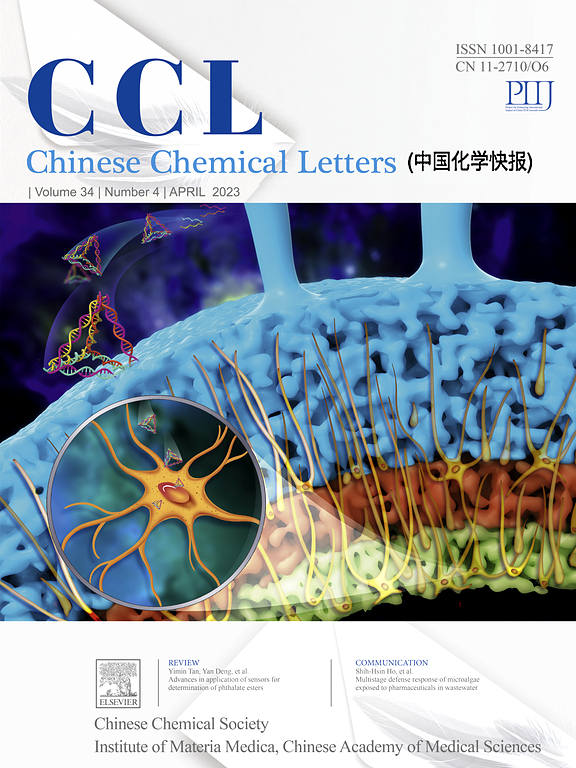Harnessing the interfacial sulfur-edge and metal-edge sites in ZnIn2S4/MnS heterojunctions boosts charge transfer for photocatalytic hydrogen production
IF 8.9
1区 化学
Q1 CHEMISTRY, MULTIDISCIPLINARY
引用次数: 0
Abstract
Rapid carrier recombination and slow charge transfer dynamics have significantly reduced the performance of photocatalytic hydrogen production. Construction of heterojunctions via utilizing the sulfur-edge and metal-edge sites of metal sulfide semiconductor for improving photocatalytic activity remains a significant challenge. Herein, a novel ZnIn2S4/MnS S-scheme heterojunction was prepared by hydrothermal synthesis to accelerate charge carrier transfer for efficient photocatalysis. Notably, ZnIn2S4/MnS exhibited excellent photocatalytic hydrogen evolution activity (7.95 mmol g−1 h−1) under visible light irradiation (≥420 nm), up to 4.7 times higher than that of pure ZnIn2S4. Additionally, cycling experiments showed that ZM-2 remained high stability after four cycles. Density-functional theory (DFT) calculations and in situ XPS results confirm the formation of S-scheme heterojunction, indicating that the tight interfacial contact between ZnIn2S4 and MnS with the presence of Mn-S bonds (the unsaturated Mn edges of MnS and the uncoordinated S atoms in the edge of ZnIn2S4) promoted faster charge transfer. Besides, the unsaturated S atom on the surface of MnS is an active site with strong H+ binding ability, which can effectively reduce the overpotential or activation barrier for hydrogen evolution. This study illustrates the critical influence of the interfacial Mn-S bond on the ZnIn2S4/MnS S-scheme heterojunction to achieve efficient photocatalytic hydrogen production and provides relevant guidance for carrying out rational structural/interfacial modulation.

利用ZnIn2S4/MnS异质结中硫边和金属边的界面位点促进光催化制氢的电荷转移
快速载流子重组和缓慢电荷转移动力学显著降低了光催化制氢的性能。利用金属硫化物半导体的硫边和金属边位置构建异质结以提高光催化活性仍然是一个重大挑战。本文采用水热合成方法制备了一种新型的ZnIn2S4/MnS S-scheme异质结,以加速载流子转移,实现高效光催化。值得注意的是,ZnIn2S4/MnS在可见光照射(≥420 nm)下表现出优异的光催化析氢活性(7.95 mmol g−1 h−1),比纯ZnIn2S4高4.7倍。此外,循环实验表明,ZM-2在4次循环后仍保持较高的稳定性。密度泛函理论(DFT)计算和原位XPS结果证实了S型异质结的形成,表明由于Mn-S键的存在(MnS的不饱和Mn边缘和ZnIn2S4边缘的不配位S原子),ZnIn2S4与MnS之间的紧密界面接触促进了更快的电荷转移。此外,MnS表面的不饱和S原子是具有较强H+结合能力的活性位点,可以有效降低析氢的过电位或激活势垒。本研究阐明了界面Mn-S键对ZnIn2S4/MnS S-scheme异质结实现高效光催化制氢的关键影响,并为进行合理的结构/界面调制提供了相关指导。
本文章由计算机程序翻译,如有差异,请以英文原文为准。
求助全文
约1分钟内获得全文
求助全文
来源期刊

Chinese Chemical Letters
化学-化学综合
CiteScore
14.10
自引率
15.40%
发文量
8969
审稿时长
1.6 months
期刊介绍:
Chinese Chemical Letters (CCL) (ISSN 1001-8417) was founded in July 1990. The journal publishes preliminary accounts in the whole field of chemistry, including inorganic chemistry, organic chemistry, analytical chemistry, physical chemistry, polymer chemistry, applied chemistry, etc.Chinese Chemical Letters does not accept articles previously published or scheduled to be published. To verify originality, your article may be checked by the originality detection service CrossCheck.
 求助内容:
求助内容: 应助结果提醒方式:
应助结果提醒方式:


